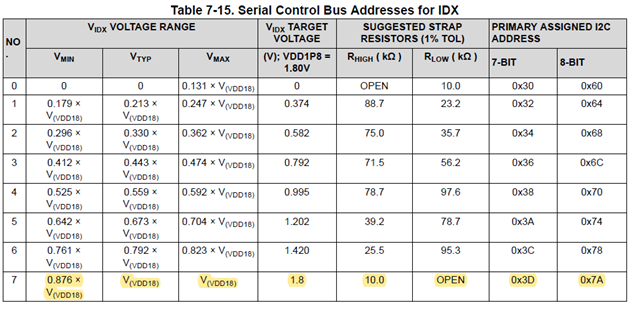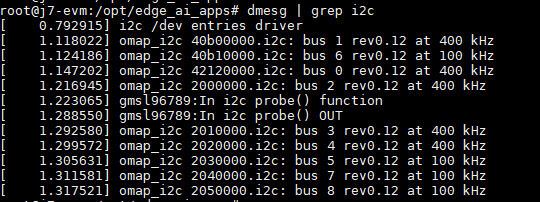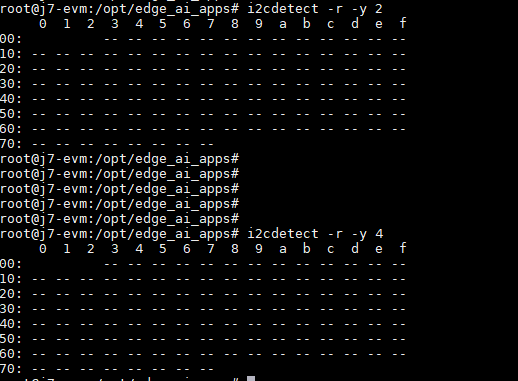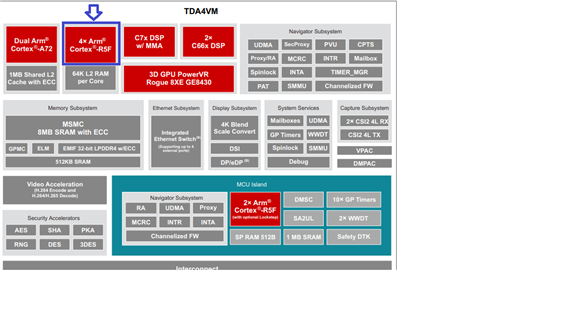Hi TI Team,
We are develop feature for camera using our customer board.
TDA4EVB use I2C_6 bus for CSI0/CSI1 camera setting.
but We modify Our board use I2C_2(CSI0) / I2C_0(CSI1) for camera init,
I followed the instructions like this post but it doesn't work: https://e2e.ti.com/support/processors-group/processors/f/processors-forum/986493/tda4vm-how-to-change-csi-camera-i2c-instance-in-vision_app
I can not read/write i2c by i2c_0 and i2c_2.
I changed are as below, Could you help us correctly?
Thank You.
1. Disable I2C0 and I2C2 in the device tree "k3-j721e-common-proc-board.dts"
&main_i2c0 {
pinctrl-names = "default";
pinctrl-0 = <&main_i2c0_pins_default>;
clock-frequency = <400000>;
status = "disabled";
exp1: gpio@20 {
compatible = "ti,tca6416";
status = "disabled";
reg = <0x20>;
gpio-controller;
#gpio-cells = <2>;
};
exp2: gpio@22 {
compatible = "ti,tca6424";
status = "disabled";
reg = <0x22>;
gpio-controller;
#gpio-cells = <2>;
p08-hog {
/* P10 - PM_I2C_CTRL_OE */
gpio-hog;
status = "disabled";
gpios = <8 GPIO_ACTIVE_HIGH>;
output-high;
line-name = "CTRL_PM_I2C_OE";
};
p09-hog {
/* P11 - MCASP/TRACE_MUX_S0 */
gpio-hog;
status = "disabled";
gpios = <9 GPIO_ACTIVE_HIGH>;
output-low;
line-name = "MCASP/TRACE_MUX_S0";
};
p10-hog {
/* P12 - MCASP/TRACE_MUX_S1 */
gpio-hog;
status = "disabled";
gpios = <10 GPIO_ACTIVE_HIGH>;
output-high;
line-name = "MCASP/TRACE_MUX_S1";
};
};
};
&main_i2c0{
status = "disabled";
}
2. Disable I2C0 and I2C2 in the device tree "k3-j721e-vision-apps.dts"
#include "k3-j721e-rtos-memory-map.dtsi"
&main_i2c6 {
status = "disabled";
};
&serdes_wiz4 {
status = "disabled";
};
&mhdp {
status = "disabled";
};
&dss {
status = "disabled";
};
&main_i2c0 {
status = "disabled";
};
&main_i2c2 {
status = "disabled";
};
&ti_csi2rx0 {
status = "disabled";
};
&ti_csi2rx1 {
status = "disabled";
};
3. Call API SET_DEVICE_STATE_ON(TISCI_DEV_I2C0) in function int32_t appCsi2TxInit(void) and int32_t appCsi2RxInit(void)
int32_t appCsi2TxInit(void)
{
int32_t status = FVID2_SOK;
uint32_t regVal = 0U, unlocked = 0U;
Csitx_InitParams initPrmsCsitx;
appLogPrintf("CSI2TX: Init ... !!!\n");
SET_DEVICE_STATE_ON(TISCI_DEV_CSI_PSILSS0);
#if defined(SOC_J721S2) || defined(SOC_J784S4)
SET_DEVICE_STATE_ON(TISCI_DEV_CSI_TX_IF_V2_0);
SET_DEVICE_STATE_ON(TISCI_DEV_CSI_TX_IF_V2_1);
#else
SET_DEVICE_STATE_ON(TISCI_DEV_CSI_TX_IF0);
#endif
SET_DEVICE_STATE_ON(TISCI_DEV_DPHY_TX0);
SET_DEVICE_STATE_ON(TISCI_DEV_I2C0);
SET_DEVICE_STATE_ON(TISCI_DEV_I2C2);
appLogPrintf("[Danh TD] SET_DEVICE_STATE_ON I2C0/I2C2 (totoal:0-6)\n");
regVal = CSL_REG32_RD(CSL_CTRL_MMR0_CFG0_BASE +
CSL_MAIN_CTRL_MMR_CFG0_LOCK1_KICK0);
if ((regVal & 0x1) == 0U)
{
/* Unlock MMR */
unlocked = 1U;
CSL_REG32_WR(CSL_CTRL_MMR0_CFG0_BASE +
CSL_MAIN_CTRL_MMR_CFG0_LOCK1_KICK0,
0x68EF3490U);
CSL_REG32_WR(CSL_CTRL_MMR0_CFG0_BASE +
CSL_MAIN_CTRL_MMR_CFG0_LOCK1_KICK1,
0xD172BC5AU);
appLogPrintf("Unlocked MMR to program CSITX DPHY register ... !!!\n");
}
/* Select CSITX0 as the source for DPHYTX0 */
CSL_REG32_WR(CSL_CTRL_MMR0_CFG0_BASE +
CSL_MAIN_CTRL_MMR_CFG0_DPHY_TX0_CTRL,
0x1);
/* Lock MMR back if unlocked here */
if (unlocked == 1U)
{
CSL_REG32_WR(CSL_CTRL_MMR0_CFG0_BASE +
CSL_MAIN_CTRL_MMR_CFG0_LOCK1_KICK0,
0U);
appLogPrintf("Locked MMR after programming CSITX DPHY register ... !!!\n");
}
Csitx_initParamsInit(&initPrmsCsitx);
initPrmsCsitx.drvHandle = appUdmaCsirxCsitxGetObj();
status = Csitx_init(&initPrmsCsitx);
if(status!=FVID2_SOK)
{
appLogPrintf("CSI2TX: ERROR: Csitx_init failed !!!\n");
}
appLogPrintf("CSI2TX: Init ... Done !!!\n");
return (status);
}
int32_t appCsi2RxInit(void)
{
int32_t status = FVID2_SOK;
Csirx_InitParams initPrmsCsirx;
appLogPrintf("CSI2RX: Init ... !!!\n");
SET_DEVICE_STATE_ON(TISCI_DEV_CSI_PSILSS0);
SET_DEVICE_STATE_ON(TISCI_DEV_CSI_RX_IF0);
SET_DEVICE_STATE_ON(TISCI_DEV_CSI_RX_IF1);
#if defined(SOC_J784S4)
SET_DEVICE_STATE_ON(TISCI_DEV_CSI_RX_IF2);
#endif
SET_DEVICE_STATE_ON(TISCI_DEV_DPHY_RX0);
SET_DEVICE_STATE_ON(TISCI_DEV_DPHY_RX1);
#if defined(SOC_J784S4)
SET_DEVICE_STATE_ON(TISCI_DEV_DPHY_RX2);
#endif
SET_DEVICE_STATE_ON(TISCI_DEV_I2C0);
SET_DEVICE_STATE_ON(TISCI_DEV_I2C2);
appLogPrintf("[Danh RX] SET_DEVICE_STATE_ON I2C0/I2C2 (totoal:0-6)\n");
Csirx_initParamsInit(&initPrmsCsirx);
initPrmsCsirx.drvHandle = appUdmaCsirxCsitxGetObj();
status = Csirx_init(&initPrmsCsirx);
if(status!=FVID2_SOK)
{
appLogPrintf("CSI2RX: ERROR: Csirx_init failed !!!\n");
}
appLogPrintf("CSI2RX: Init ... Done !!!\n");
return (status);
}
4. Check "J721E_pinmux_data.c"
static pinmuxPerCfg_t gI2c0PinCfg[] =
{
/* MyI2C0 -> I2C0_SCL -> AC5 */
{
PIN_I2C0_SCL, PIN_MODE(0) | \
((PIN_PULL_DIRECTION | PIN_INPUT_ENABLE) & (~PIN_PULL_DISABLE))
},
/* MyI2C0 -> I2C0_SDA -> AA5 */
{
PIN_I2C0_SDA, PIN_MODE(0) | \
((PIN_PULL_DIRECTION | PIN_INPUT_ENABLE) & (~PIN_PULL_DISABLE))
},
{PINMUX_END}
};
static pinmuxPerCfg_t gI2c2PinCfg[] =
{
/* FPD_LINK CL1 -> I2C2_SCL -> AA1 */
{
PIN_SPI0_CLK, PIN_MODE(2) | \
((PIN_PULL_DIRECTION | PIN_INPUT_ENABLE) & (~PIN_PULL_DISABLE))
},
/* FPD_LINK CL1 -> I2C2_SDA -> AB5 */
{
PIN_SPI0_D0, PIN_MODE(2) | \
((PIN_PULL_DIRECTION | PIN_INPUT_ENABLE) & (~PIN_PULL_DISABLE))
},
{PINMUX_END}
};
static pinmuxModuleCfg_t gI2cPinCfg[] =
{
{0, TRUE, gI2c0PinCfg},
{1, TRUE, gI2c1PinCfg},
{2, TRUE, gI2c2PinCfg},
{3, TRUE, gI2c3PinCfg},
{6, TRUE, gI2c6PinCfg},
{PINMUX_END}
};
pinmuxBoardCfg_t gJ721E_MainPinmuxData[] =
{
{0, gDebugssPinCfg},
{1, gGpioPinCfg},
{2, gI2cPinCfg},
{3, gMcanPinCfg},
{4, gMdioPinCfg},
{5, gMlbPinCfg},
{6, gMmcsdPinCfg},
{7, gSystemPinCfg},
{8, gUartPinCfg},
{9, gUsbPinCfg},
{10, gMcaspPinCfg},
{PINMUX_END}
};
5. Change I2C bus and address in function "Board_fpdU954GetI2CAddr"
void Board_fpdU954GetI2CAddr(uint8_t *chNum,
uint8_t *i2cAddr,
uint32_t csiInst)
{
//J7_TODO: Need to update to make it generic across the devices and platforms
if (csiInst == BOARD_CSI_INST_0)
{
*chNum = 2U;
// *i2cAddr = 0x3DU; /* 7-bits mode address */
*i2cAddr = 0x7AU; /* 8-bits mode address */
}
else if (csiInst == BOARD_CSI_INST_1)
{
*chNum = 0U;
// *i2cAddr = 0x30U; /* 7-bits mode address */
*i2cAddr = 0x60U; /* 8-bits mode address */
}
else
{
*chNum = 0U;
*i2cAddr = 0U;
}
}
Our Board Using address as below:






